Celebrating the resistor!
Parts can be fascinating, even simple passives with their parasitics making even a resistor a complex component.
I have some vintage passives, and some of the production/packaging amazes me, such that some are individually packaged - even with hand written labels in each bag.
Being one that enjoys the uncertainties of a circuit character depending on parts, (mostly for guitar amplifiers), it is nice to see the parasitics and their effects are easily measurable.
Lets just say there is no wonder these vintage resistors give a 'vintage' rounded/warm sound. The larger the resistance value, the more the capacitance effects the resistance, obviously, and the lack of inductance in these parts certainly makes the C very dominant. Modern metal films seem to have more inductance, perhaps intentionally to compensate for the capacitance. ?
The 0.25W CCs are actually pretty good, only 0.1-0.18pF, about as good as modern (boring?) MFs. Values below 1kohm are pretty much flat up above 10MHz. The low values are very good with only the lead inductance, less than a modern MF. Of course, a CC have other issues, but for many uses the small size CC can be very good resistors indeed.
Beyschlag 2W 150kohm and 1800ohm has 0.7 - 0.9pF in parallel.
AB 2W CC have almost 3pF in parallel, rolling off the resistance a little over 10kHz! (Note the grid is 10kohm/div! - yellow trace is resistance)
BTW, the Electrosil 2W tin-oxides look very well made, are non magnetic, and measure well. Any info on those? I try to find some out on the web, not much to be found.
Parts can be fascinating, even simple passives with their parasitics making even a resistor a complex component.
I have some vintage passives, and some of the production/packaging amazes me, such that some are individually packaged - even with hand written labels in each bag.
Being one that enjoys the uncertainties of a circuit character depending on parts, (mostly for guitar amplifiers), it is nice to see the parasitics and their effects are easily measurable.
Lets just say there is no wonder these vintage resistors give a 'vintage' rounded/warm sound. The larger the resistance value, the more the capacitance effects the resistance, obviously, and the lack of inductance in these parts certainly makes the C very dominant. Modern metal films seem to have more inductance, perhaps intentionally to compensate for the capacitance. ?
The 0.25W CCs are actually pretty good, only 0.1-0.18pF, about as good as modern (boring?) MFs. Values below 1kohm are pretty much flat up above 10MHz. The low values are very good with only the lead inductance, less than a modern MF. Of course, a CC have other issues, but for many uses the small size CC can be very good resistors indeed.
Beyschlag 2W 150kohm and 1800ohm has 0.7 - 0.9pF in parallel.
AB 2W CC have almost 3pF in parallel, rolling off the resistance a little over 10kHz! (Note the grid is 10kohm/div! - yellow trace is resistance)
BTW, the Electrosil 2W tin-oxides look very well made, are non magnetic, and measure well. Any info on those? I try to find some out on the web, not much to be found.
Attachments
-
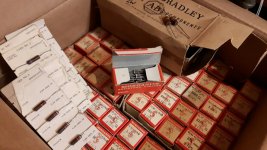 CC_box.jpg329.9 KB · Views: 288
CC_box.jpg329.9 KB · Views: 288 -
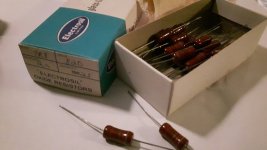 Electrosil_oxfilm.jpg258.5 KB · Views: 285
Electrosil_oxfilm.jpg258.5 KB · Views: 285 -
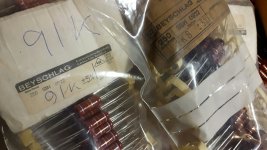 Beyschlag.jpg265.8 KB · Views: 275
Beyschlag.jpg265.8 KB · Views: 275 -
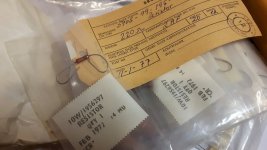 RAF_CF_individual.jpg256.5 KB · Views: 268
RAF_CF_individual.jpg256.5 KB · Views: 268 -
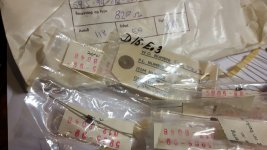 025CC.jpg243.7 KB · Views: 275
025CC.jpg243.7 KB · Views: 275 -
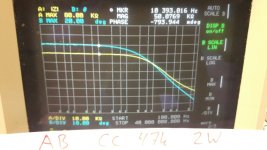 AB2WCC_10kHz.jpg265 KB · Views: 411
AB2WCC_10kHz.jpg265 KB · Views: 411 -
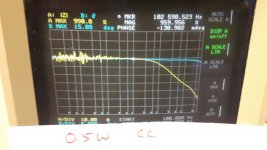 05CC_100kHz.jpg241.2 KB · Views: 190
05CC_100kHz.jpg241.2 KB · Views: 190 -
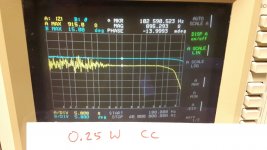 025CC_100kHz.jpg257.7 KB · Views: 171
025CC_100kHz.jpg257.7 KB · Views: 171 -
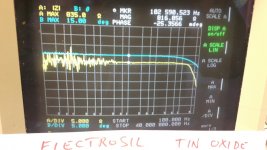 Electrosil820_100kHz.jpg283.7 KB · Views: 169
Electrosil820_100kHz.jpg283.7 KB · Views: 169 -
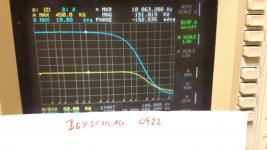 BC150k_10kHz.jpg227.8 KB · Views: 168
BC150k_10kHz.jpg227.8 KB · Views: 168
Do you mean the Electrosils?I really like the looks of them over the newer types
Are you selling any of them ?
Well, the dream of needing all my parts because I am a big time producer of audio gear is alive but not so well. So I guess I can safely part with some of them. How many do you need?
I came across this thread with searching "Electrosil" keyword. There are just couple of threads mentioning these interesting resistors. This one and the mine one (link below) are just one of them.
Had you any chance to measure regular modern metal film and carbon film types in order to compare with these vintage resistors? It would be great to compare these vintage ones with more common CF/MF types.
I have a stash of vintage resistors and I'm trying to decide which one could be the ideal for use as NFB resistor.
Had you any chance to measure regular modern metal film and carbon film types in order to compare with these vintage resistors? It would be great to compare these vintage ones with more common CF/MF types.
I have a stash of vintage resistors and I'm trying to decide which one could be the ideal for use as NFB resistor.
Hi, I had these NOS resistors from military surplus market. I have no idea about manufacturer and type (CF, MF, etc.). They measure 1% (actually better) tolerance range. Non-magnetic. I'm familiar with Beyschlag resistors but these ones are quite different in shape and color. Also doesn't look like Piher's but I'm not sure.
Dimensions are 14x4x90mm. The leads are very thick for such sized resistor. Lead diameter is 1mm.
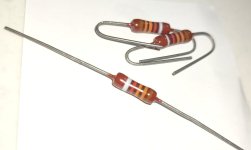
Dimensions are 14x4x90mm. The leads are very thick for such sized resistor. Lead diameter is 1mm.

- terranigma
- Replies: 5
- Forum: Parts
Last edited:
The roll off shown on the trace is at around 1MHz, the roll off knee is defined as the 3dB point (45 degrees in phase). This corresponds to about 3pF using the f = 1/(2*pi*R*C) formula. To be precise the resistance itself doesn't roll off, the impedance rolls off.AB 2W CC have almost 3pF in parallel, rolling off the resistance a little over 10kHz! (Note the grid is 10kohm/div! - yellow trace is resistance)
The potential show-stopper with CC resistors is that the value changes over time and with humidity. There one saving grace is high transient overload handling.
The Electrosil resistors are metal-oxide. Metal oxide have largely died out as metal film outperform them (for through hole components), whereas for surface mount resistors metal-oxide (aka "thick film") resistors dominate as they are cheaper to make. Surface mount "thin film" resistors are metal film types.